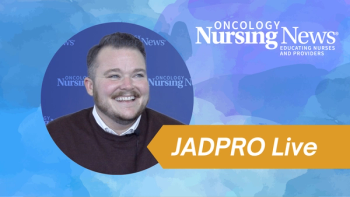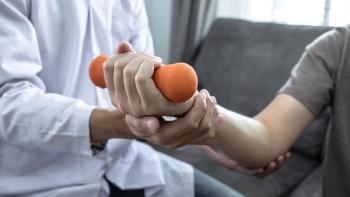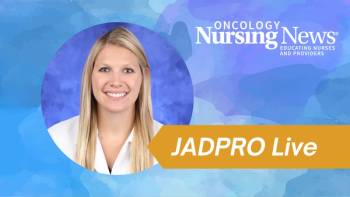
PI3K and AKT Inhibitor Toxicity Advice From a Breast Cancer Expert
Hope S. Rugo, MD, FASCO, outlined the top considerations for nurses managing toxicities related to PI3K and AKT inhibitors in patients with breast cancer.
As targeted therapies like capivasertib (Truqap) gain traction in hormone receptor–positive breast cancer, oncology nurses and advanced practice providers (APPs) must be proactive in patient education and managing toxicities like hyperglycemia, rash, and gastrointestinal toxicities, explained Hope S. Rugo, MD, FASCO, the division chief of breast medical oncology, as well as director of the Women's Cancers Program at City of Hope in Duarte, California.
In an interview with Oncology Nursing News at the 24th Annual
She also mentioned that rashes and diarrhea can be managed proactively with antihistamines and loperamide, respectively. Rugo stressed that patients should be informed that if they don’t proactively take antihistamines, a recurrent or chronic rash could develop.
Oncology Nursing News: Why is it important to assess a patient's glucose control before starting capivasertib?
When patients have a prior history of hyperglycemia, [that should be taken into consideration] but most patients aren’t coming in and telling you they have borderline glucose control. You need a hemoglobin A1C; you need a fasting glucose. You need to understand body mass index and diet for these patients. Regardless of which drug you’re choosing, manage this proactively. It’s important.
Hemoglobin A1C can be used more liberally when you’re starting capivasertib, and you don’t get that immediate hyperglycemia that we used to see with alpelisib (Piqray). That’s good, but if a patient’s glucose goes up, you want to be more heavy-handed on using Glucophage as an initial approach to try and keep the glucose under a manageable level. I found that patients did very well if they needed it, but very few patients needed an additional drug.
How can patient education help proactively manage hyperglycemia for patients taking capivasertib?
If a patient has an infection or isn’t feeling good, education is critical with capivasertib and all the drugs that cause hyperglycemia, because they won’t have had a high glucose before. Their glucose is normal. If they get sick, the glucose could go up even if they have normal glycemic control.
Now for patients, I’m encouraging [my practice] to tell them, “If you don’t feel good, don’t take the dose that evening. Call in in the morning.” It’s such an easy management strategy, because [otherwise] they take the dose, they call in, somebody calls them back, then they go to the emergency department and check their labs, and their glucose level is 300 mg/dL.
One of my patients had a glucose level of 491 mg/dL, and we still don’t know why. On Monday, her glucose was normal. She’d been on [capivasertib] for 8 weeks. It was around a holiday night, so she probably was eating a very different diet, and maybe she had some infection that we didn’t find, and her glucose was high. She did not have diabetic ketoacidosis. We put her on Glucophage, held [capivasertib] and her glucose became normal. We eventually restarted her on a dose reduction of capivasertib after a few days, and she didn’t need Glucophage anymore.
It’s interesting that the management must be very individualized, but you must think ahead and tell people, “
How does management of rash differ from other AEs for patients taking capivasertib?
We have no idea who gets a rash—and rash can be a big deal—so we want to be proactive with that. There’s no reason why [every patient with breast cancer receiving PI3K or AKT inhibitors] shouldn’t take twice daily non-sedating antihistamines for a premedication starting the day before and then continue it through.
If you get a rash, we treat it with topical steroids, and we treat a grade 3 rash with oral steroids, but it can be hard to manage if a patient gets a grade 3 rash, because they will keep getting a rash, sometimes even when you dose reduce.
That sort of
Mouth sores are different from rashes: you treat them if they occur. It works just as well as premedication if you treat them once they’ve occurred. You just don’t want a bad mouth sore. Rash is a different thing. You must do the preventive strategy. It’s very important. Tell patients why it’s more important to do prevention than treatment [with rashes].
What other AEs should nurses and APPs look out for when treating patients taking PI3K or AKT inhibitors?
The last thing is diarrhea, which is interesting. Diarrhea is [linked with] these agents. It seems to be a little bit more with capivasertib than with some of the other drugs, although we saw it as a late issue with alpelisib along with weight loss, and inavolisib [Itovebi] has the same feature. But diarrhea occurs with the
Something important that sometimes people don’t realize is that they can cut the pill in half. Just tell people, “OK, you’re going to go out and have a big salad at lunch. You’re going to go for a big hike in the woods where there’s no bathroom. Take a half of an Imodium before you go. If you get bad diarrhea, take a whole Imodium.” You can titrate it, and it really helps people’s quality of life a lot.
This transcript has been edited for clarity and conciseness.


















































































